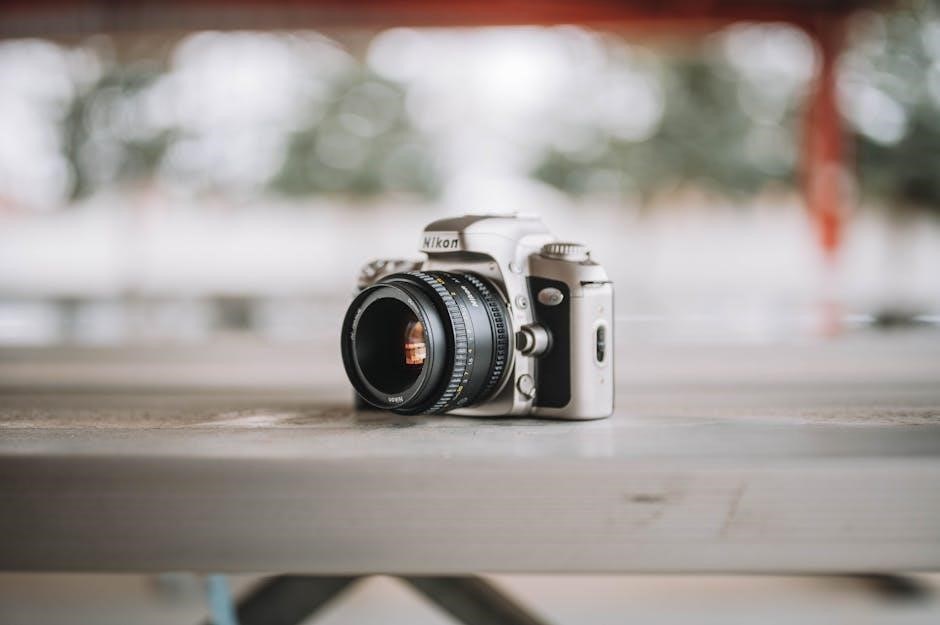The Nikon D3100 is an entry-level DSLR camera designed for beginners‚ offering excellent image quality and ease of use. Its manual provides detailed guidance for mastering the camera’s features‚ ensuring users can capture stunning photos and videos effortlessly.
1.1 Overview of the Nikon D3100 Camera
The Nikon D3100 is a compact and lightweight entry-level DSLR camera designed for photography enthusiasts. It features a 14.2-megapixel CMOS sensor‚ EXPEED 2 image processor‚ and an ISO range of 100-12‚800. The camera supports Full HD video recording and offers a variety of shooting modes. Its intuitive interface makes it ideal for beginners‚ while advanced features cater to those seeking creative control. With a 3.0-inch LCD screen and ergonomic design‚ the D3100 is a versatile tool for capturing high-quality images and videos effortlessly.
1.2 Key Features and Benefits
The Nikon D3100 stands out with its 14.2MP CMOS sensor‚ delivering crisp and vibrant images. It offers an ISO range of 100-12‚800‚ excellent for low-light photography. The camera supports Full HD video recording and features an 11-point autofocus system for precise subject tracking. Its Guide Mode simplifies complex settings‚ making it ideal for beginners. Additionally‚ the D3100 is compatible with a wide range of NIKKOR lenses‚ providing versatility for diverse shooting needs. These features combine to make it an excellent choice for both new and aspiring photographers.

Camera Modes and Shooting Options
The Nikon D3100 offers versatile shooting modes‚ including Auto‚ Scene‚ and Manual‚ catering to both beginners and advanced photographers. These modes enable optimal control over settings for diverse photography needs.
2.1 Automatic Mode
The Automatic Mode on the Nikon D3100 simplifies photography by adjusting settings like aperture‚ shutter speed‚ and ISO for optimal results. This mode is ideal for beginners‚ allowing them to focus solely on composition and subject without worrying about technical details. The camera automatically detects scene types and adjusts accordingly‚ ensuring vibrant colors and sharp focus. It’s perfect for capturing casual moments‚ portraits‚ and everyday scenes with ease and efficiency.
2.2 Scene Modes
The Nikon D3100 offers a variety of Scene Modes tailored for specific shooting situations‚ such as Portrait‚ Landscape‚ Night Portrait‚ and Close-up. These modes automatically optimize settings like aperture‚ shutter speed‚ and ISO to capture the best results in different conditions. Portrait mode emphasizes subject sharpness‚ while Landscape mode enhances depth and detail. Night Portrait balances flash and ambient light‚ and Close-up focuses on macro-style shots. These modes simplify photography‚ allowing users to achieve professional-looking results without manual adjustments.
2.3 Manual Mode
Manual Mode on the Nikon D3100 offers full control over camera settings‚ allowing users to adjust aperture‚ shutter speed‚ and ISO sensitivity. This mode is ideal for experienced photographers who want precise control over their shots. By manually setting these parameters‚ users can achieve creative effects‚ such as depth of field or motion blur. The camera’s manual mode is supported by the intuitive interface‚ making it easier to experiment with different settings and capture images exactly as envisioned. This feature is essential for mastering advanced photography techniques.

Custom Settings and Configuration
The Nikon D3100 allows users to customize settings like ISO sensitivity‚ white balance‚ and autofocus modes‚ enabling tailored shooting preferences and enhanced creativity in various photography scenarios.
3.1 ISO Sensitivity
ISO sensitivity on the Nikon D3100 ranges from 100 to 3200‚ with the option to extend up to 6400 in Hi 1 mode. Lower ISO settings like 100 or 200 are ideal for bright lighting conditions‚ minimizing noise for crisp images. Higher ISOs‚ such as 1600 or 3200‚ are better suited for low-light situations‚ allowing for faster shutter speeds. However‚ using high ISOs can introduce noise‚ affecting image quality. The camera’s ISO settings can be manually adjusted to suit various lighting conditions‚ offering flexibility for photographers to balance noise and image brightness effectively.
3.2 White Balance Settings
The Nikon D3100 offers various White Balance settings to ensure accurate color reproduction. Options include Auto‚ Daylight‚ Fluorescent‚ Incandescent‚ and Cloudy‚ each tailored to specific lighting conditions. The camera also features a Preset Manual mode‚ allowing users to set a custom white balance using a reference object. Fine-tuning is possible‚ enabling adjustments to suit personal preferences or unique lighting scenarios. This flexibility ensures colors remain natural and vibrant‚ enhancing the overall quality of captured images in diverse environments.
3.3 Autofocus Modes
The Nikon D3100 features advanced autofocus modes to enhance shooting precision. Single AF (AF-S) is ideal for stationary subjects‚ focusing quickly and accurately. Continuous AF (AF-C) tracks moving subjects‚ adjusting focus dynamically. Manual focus (MF) allows precise control for creative shots. The camera also supports automatic AF selection‚ switching between AF-S and AF-C based on subject movement. These modes ensure sharp images in various scenarios‚ from portraits to action photography‚ offering flexibility and reliability for photographers of all skill levels.
Accessories and Compatibility
The Nikon D3100 supports various accessories‚ including external flash units‚ compatible lenses‚ and tripods‚ enhancing its functionality and versatility for different photography needs and styles.
4.1 External Flash Units
The Nikon D3100 is compatible with Nikon’s Speedlight flash system‚ enabling enhanced lighting control for various photography situations. Popular external flash units like the SB-300 and SB-700 can be used to improve lighting‚ reduce shadows‚ and achieve professional results. These flashes can be mounted on the camera’s hot shoe or triggered wirelessly‚ offering flexibility. Using genuine Nikon accessories ensures optimal performance and compatibility. Always refer to the manual for proper setup and configuration of external flash units with the D3100.
4.2 Compatible Lenses
The Nikon D3100 is compatible with a wide range of Nikon F-mount lenses‚ including AF-S and AF-I models. Popular choices include the kit lens‚ AF-S DX NIKKOR 18-55mm‚ and other DX-format lenses. Telephoto and wide-angle lenses like the AF-S DX NIKKOR 55-200mm and AF-S DX NIKKOR 10-24mm are also supported. Prime lenses‚ such as the AF-S DX NIKKOR 35mm f/1.8G‚ offer exceptional sharpness. While older manual-focus lenses can be used‚ they require manual operation. Always consult the manual for a full list of compatible lenses.
4.3 Tripods and Remote Shutter Release
Using a tripod with the Nikon D3100 ensures stability‚ especially in low-light conditions or for long exposures. The camera supports standard tripod mounts‚ and Nikon recommends using its branded tripods for optimal compatibility. A remote shutter release‚ like the ML-L3‚ minimizes camera shake during shooting. This accessory is ideal for time-lapse photography or self-portraits. Third-party remotes and apps are also available but ensure they are compatible with the D3100. Always consult the manual for proper setup and usage guidelines.

Troubleshooting and Maintenance
Regularly clean the sensor and lens to avoid smudges. Consult the manual for solutions to common issues like error messages or firmware updates.
5.1 Common Issues and Solutions
Common issues with the Nikon D3100 include camera freezing‚ memory card errors‚ and autofocus malfunctions. For freezing‚ restart the camera or update firmware. Memory card errors often require formatting the card in the camera. Autofocus issues may stem from lens misalignment or dirty sensors‚ which can be resolved by cleaning the lens and sensor or recalibrating the lens. Refer to the manual for detailed troubleshooting steps to resolve these problems effectively.
5.2 Cleaning and Maintenance Tips
Regularly clean the camera sensor with a soft brush or blower to prevent dust spots. Use a microfiber cloth to wipe the lens and LCD screen‚ avoiding harsh chemicals. For stubborn smudges‚ dampen the cloth slightly with distilled water. Store the camera in a dry‚ cool place to prevent moisture damage. Format memory cards in the camera to maintain optimal performance. Clean the battery contacts with a soft cloth for reliable power. Follow these maintenance tips to ensure your Nikon D3100 functions at its best.
Additional Resources
Download the Nikon D3100 manual in PDF for detailed guidance. Utilize the Nikon Manual Viewer 2 app for offline access. Explore online forums for tips and troubleshooting.
6.1 Downloading the Nikon D3100 Manual
The Nikon D3100 manual is available for free download in Spanish as a PDF. It provides comprehensive guidance on camera functions‚ modes‚ and troubleshooting. The manual can be accessed from official Nikon websites or trusted third-party sources. Ensure to verify the file’s authenticity and size‚ typically around 16.58 MB. Downloading the manual is essential for understanding advanced features and optimizing your photography experience. It’s also available through the Nikon Manual Viewer 2 app for offline access on smartphones and tablets.

6.2 Nikon Manual Viewer 2 App
The Nikon Manual Viewer 2 app allows users to download and view Nikon camera manuals offline. Compatible with iOS and Android devices‚ it provides easy access to the Nikon D3100 manual in Spanish. The app is ideal for photographers who need quick reference guides without internet connectivity. It ensures that users can explore camera features‚ shooting modes‚ and troubleshooting tips anytime‚ making it a valuable resource for both beginners and experienced photographers.
6.3 Online Communities and Forums
Online communities and forums dedicated to the Nikon D3100 provide valuable resources for users. These platforms allow photographers to share experiences‚ ask questions‚ and learn from experts. Discussions often cover camera settings‚ troubleshooting‚ and creative techniques. Many forums also offer access to downloadable guides‚ tutorials‚ and user-generated content. Engaging with these communities can enhance your understanding of the camera and improve your photography skills. They serve as a supportive space for both beginners and advanced photographers to connect and grow.
